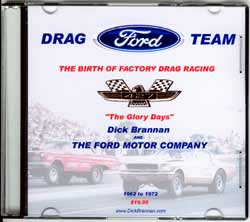 Legendary
Dick Brannan was Mr. Ford in the 1960s and ‘70s.
Brannan is THE man who got Ford heavily involved in drag
racing, through the original factory Ford Drag Council,
which he helped create. He ran everything from early Super
Stockers to injected fuel Funny Cars to Pro Stockers in
1970, when the class was invented, and won a slew of AHRA
and NHRA championships. Brannan stopped racing in 1972
because Ford got out of racing. “They pulled the
cars,” he says. He recently retired from selling
airplanes, his other profession.
Legendary
Dick Brannan was Mr. Ford in the 1960s and ‘70s.
Brannan is THE man who got Ford heavily involved in drag
racing, through the original factory Ford Drag Council,
which he helped create. He ran everything from early Super
Stockers to injected fuel Funny Cars to Pro Stockers in
1970, when the class was invented, and won a slew of AHRA
and NHRA championships. Brannan stopped racing in 1972
because Ford got out of racing. “They pulled the
cars,” he says. He recently retired from selling
airplanes, his other profession.
Brannan’s racing career is neatly biographied in
a new CD titled “The Glory Days, Dick Brannan and
The Ford Motor Company, 1962 to 1972 ($19.95, www.DickBrannan.com).”
In it, you’ll see his first hot rod, a flathead-powered
’32 coupe that he built as a kid, his ’62
Galaxie, his first Thunderbolt (and one of the first 11
that came directly from the factory), and his forays into
early Funny Car racing (remember his “Lively One”
and “Bronco” stretched Mustangs?), the great
match race days of Ford vs. Mopars vs. Chevys and Ponchos,
and his last racing exploits that saw the birth of multi-class
Super Stockers and Pro Stockers. Also presented are photos,
notes, magazine and drag paper stories, many from Brannan’s
own private files and many never seen before.
In between, you’ll learn that Brannan was a fierce
competitor at a time when drag racing was on par in nationwide
popularity with its counterpart in racing, NASCAR, and
a Saturday night win at a local track might be heralded
in a hometown Sunday paper’s sports section. One
example of Brannan’s mechanical/racing acumen: it
was no accident that Dick beat two Ford factory guys in
his ’62 Galaxie at Detroit Dragway in 1962 (a race
that set his name in the drag racing books as legendary),
because he had earlier torn the entire car down to its
frame and set it up for drag racing, with correct chassis-weighing
on all four corners. He also made his own traction bars
and even used a “hill holder” as an early
line lock, to hold the car on the starting line until
the clutch pedal was side-stepped.
Through the CD, we learn that Brannan blueprinted his
406 engine to factory specs --- all book-legal at the
time, as the practice still is today (just ask any good
NHRA or IHRA Stock Eliminator racer) --- and even beefed
up and reworked the Galaxie’s shift linkage and
clutch system, plus degreed in the engine’s camshaft
and changed the stock valve lash for added horsepower.
Those two Ford “hired drivers” didn’t
have a chance on that March night in Detroit in 1962.
“I wasn’t a better driver, I was just ready,”
Dick says on the CD.
We follow Brannan through his “lightweight”
days, racing out of the Romy Hammes’ dealership
sponsorship in South Bend, Indiana, to the birth of the
fabulous Ford Thunderbolt, the factory’s serious
entry into the Super Stock/A/Factory Experimental wars
against Chrysler and “the General’s”
drag racing entries; the early Mustang Funny Cars that
were mandated by Ford honchos to look less “Funny”
than their competitors’; through Modifieds and Super
Stockers (Brannan had the factory’s only Modified
Maverick, although Georgia buddy and teammate Phil Bonner
built one himself, thus making only two of the unique
race cars) and into modern Super Stockers and Pro Stockers.
Sure, Brannan was the first to get the best stuff that
Ford had to offer, but he passed it on to others. And
one wonders, after perusing “The Glory Days”
CD what it would have been like for him (and us) if the
factory hadn’t pulled out of racing in ’72.
But we still come away from its viewing with a great respect
for the man who rightly could be called the Godfather
of Super Stock racing. 
(DRO note: See also Dale Wilson's column, Mr.
Wilson's People, for more information about Dick Brannan
and Jake Bonner, his young protégé.)

